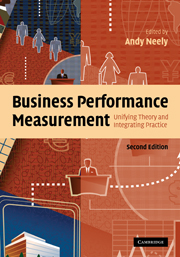Book contents
- Frontmatter
- Contents
- List of figures
- List of tables
- List of boxes
- List of contributors
- Introduction
- Part I Performance measurement – functional analyses and theoretical foundations
- Part II Performance measurement – frameworks and methodologies
- Part III Performance measurement – practicalities and challenges
- 11 Choosing marketing dashboard metrics
- 12 Risk in performance measurement
- 13 Measuring knowledge work
- 14 Measuring innovation performance
- 15 Context-based measurement
- Part IV Performance measurement in public services
- Part V Performance measurement – emerging issues and enduring questions
- Index
- References
12 - Risk in performance measurement
Published online by Cambridge University Press: 22 September 2009
- Frontmatter
- Contents
- List of figures
- List of tables
- List of boxes
- List of contributors
- Introduction
- Part I Performance measurement – functional analyses and theoretical foundations
- Part II Performance measurement – frameworks and methodologies
- Part III Performance measurement – practicalities and challenges
- 11 Choosing marketing dashboard metrics
- 12 Risk in performance measurement
- 13 Measuring knowledge work
- 14 Measuring innovation performance
- 15 Context-based measurement
- Part IV Performance measurement in public services
- Part V Performance measurement – emerging issues and enduring questions
- Index
- References
Summary
Introduction
Qui ne risque rien n'a rien (Nothing ventured, nothing gained)
Companies are in the business of earning returns for shareholders as a result of taking risks, and we expect there to be a relationship between the two. Why put capital at significant risk for a return that is no higher than the return on government bonds? Or expect higher than average returns from low-risk activities? It is impossible to separate measuring the performance of a company from the risks that the management takes to achieve it.
Investors can reasonably expect greater rewards for specific risks, such as investing in start-ups or in parts of the world subject to civil war, than investing in more established and stable companies, in safe industries or in settled environments. Nonetheless, risk rarely figures when company performance is described. Financial measures are almost invariably given (“Our profits rose by 15 per cent”, “The company earned 23 per cent on invested capital”) without any risk context, even when comparisons are made or in any accompanying commentary. While average return is acceptable for an average risk, however, it is not for a highly risky venture. Without defining the context of risk, judgements about performance will be incomplete.
In most aspects of company operations, risk assessment plays a different, but equally important, role. It is an integral part of informed decision taking in achieving performance.
- Type
- Chapter
- Information
- Business Performance MeasurementUnifying Theory and Integrating Practice, pp. 261 - 278Publisher: Cambridge University PressPrint publication year: 2007
References
- 4
- Cited by

